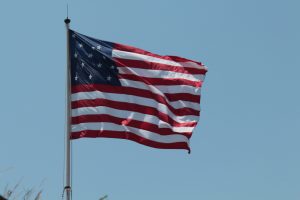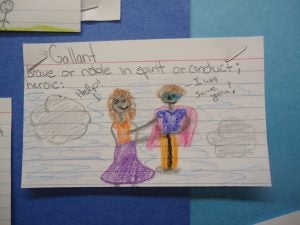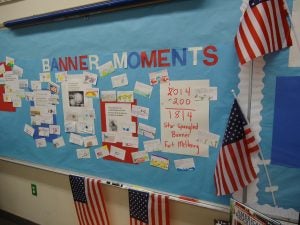
American History, Language Arts
Grade Levels: 3–5
by Ann Coyne (Inverness Primary School, Inverness, FL) and Christy Pettee (Ponderosa Elementary, Santa Clara, CA)
We envision two teacher-ready lessons. The first lesson will center around using primary and secondary sources to learn the historical context of the Star Spangled Banner. The second lesson will focus on the correct meaning of selected vocabulary within the lyrics. The culminating activity will consist of the students performing a choral reading with solo parts and actions. Finally, they will sing the national anthem.
Goals and Objectives
- Students will gain experience using and analyzing primary sources.
- Students will learn the historical context of the origins of the Star Spangled Banner.
- Students will gain experience in using dictionaries to correctly identify the correct meaning of a word in context.
- Students will learn the meaning of the key vocabulary words in the Star Spangled Banner.
- Students will perform the national anthem.
Materials Needed
– Primary Source:
- Original 1814 Broadside of Key’s “Defense of Fort McHenry(1 per student),with written_document_analysis_worksheet on back.
– Additional Primary Sources (4-5 copies of each):
- Calhoun to Pickersgill receipt for SSB,
- A View of the Bombardment, 1814 .
- Caroline Purdy letter 1876
- Original Sheet Music for The Star-Spangled Banner
- Map of Battle of Ft. McHenry
- written_document_analysis_worksheet
- photo/ painting analysis_worksheet
- map_analysis_worksheet
- Video: The Battle of Fort McHenry, Through Francis Scott Keyes’ Eyes
- Video: Founding Fragments – Star-Spangled Souvenirs –
- Chart paper, markers
- Index cards, 4″x 6″ – (5 – 10 per student)
- Audio performance of the Star Spangled Bannerr
- Printed copy of Star Spangled Banner – one per student
- Dictionaries
Activity #1: Developing a Historical Context for the Star Spangled Banner
- Ask the students what they know about the Star Spangled Banner (teacher will list facts on the board/chart).
- Tell the students that they will be using primary sources to discover the story of the Star Spangled Banner. Introduce the concept of a primary source by telling the students that a primary source is an actual artifact from the time period being studied. Legal notices, letters, diaries, newspapers, maps, flags, important documents, political cartoons, and clothes are all good examples. Historians use these clues to piece together what really happened in the past, kind of like detectives. As a group, model how to use a source to yield information with one of the primary sources, using the corresponding primary source analysis sheet. I recommend using either the original 1814 Broadside or the Mary Pickersgill receipt for the Star Spangled Banner.
- Divide students into groups of approximately 3-4 students. Assign each group a particular primary source to analyze, using the respective primary analysis sheets. As they work to discover the historical background of the Star Spangled Banner, the students will record their discoveries on a chart.
- When finished, come together as a class and conduct a reflective discussion to assess what information they were able to glean from the sources. Create a class chart titled, “Facts About the Origins of the Star Spangled Banner,” and add all the information the students have found.
- Show the students a secondary source video on the Star Spangled Banner. Secondary sources are second-hand accounts of an event. Examples may include encyclopedias, textbooks and films. As the students watch the film, ask them to consider the information and how it matches with the primary sources they looked at earlier. Also, ask them to listen for new information. When finished, add any new information the students learned from the secondary source to the “Facts About the Origins of the Star Spangled Banner” chart.
Formative Assessment: Have students write out the story of the origin of the SSB using their notes. Challenge the students to include as much information as they can, using their notes.
Activity #2: The Vocabulary of the National Anthem
- Gather the students together and listen to a performance of the first verse of the national anthem.
- After listening to the first verse of the National Anthem, students underline any words they feel are important. Place particular emphasis on the following vocabulary words: dawn, proudly, hailed, twilight, gleaming, broad, perilous, ramparts, gallantly, streaming, glare, bombs, proof, spangled, banner, wave, free, and brave.
- Ask the students to take each word separately and look it up in the dictionary. They will select what definition they think correctly relates to the National Anthem, as many of them will have multiple definitions. They will write the word and correct meaning on an index card. Finally, they will illustrate the word. Model this activity with the word, “Dawn” 1. to begin to be day, grow light. 2. to come forth. 3. to begin to be understood or felt. 4. the beginning of daybreak. Teach them to consider the historical context of the song lyrics, the part of speech of the word, and what seems to make the most sense.
- While students are working independently, illustrated index cards can be used to make a bulletin board.


- After all words have been discussed and illustrated, have the students stand in a large circle. Students will do a choral reading of the first verse of the anthem. Assign individuals different vocabulary words. As the class pauses after reading each line, one student will step forward to deliver the important word and its definition. Additional concentric circles can be added for larger groups of students. Students may sing the National Anthem to conclude the performance.
Formative Assessment: Students will rewrite the first verse of the anthem, using their own terminology and interpretation.
Standards
4th Grade:
CCSS.ELA-LITERACY.RI.4.1 Refer to details and examples in a text when explaining what the text says explicitly and when drawing inferences from the text.
CCSS.ELA-LITERACY.RI.4.3 Explain events, procedures, ideas, or concepts in a historical, scientific, or technical text, including what happened and why, based on specific information in the text. Context Complexity; Strategic Thinking & Complex Reasoning 5th Grade:
CCSS.ELA-LITERACY.RI.5.1 Quote accurately from a text when explaining what the text says explicitly and when drawing inferences from the text.
CCSS.ELA-LITERACY.RI.5.2Determine two or more main ideas of a text and explain how they are supported by key details; summarize the text.
CCSS.ELA-LITERACY.RI.5.3Explain the relationships or interactions between two or more individuals, events, ideas, or concepts in a historical, scientific, or technical text based on specific information in the text.
Other Resources:
The Story of “The Star Spangled Banner.” by Patricia A. Pingry, Illustrated by Nancy Munger. Candy Cane Press. Nasheville, TN. 2005
The Flag Maker. by Susan Campbell Baroletti, Illustrated by Claire A. Nivola. Houghton Mifflin Company. Boston 2004
History Speaks … The Star-Spangled Banner. by Douglas M. Rife, Illustrated by Bron Smith. Teaching and Learning Company, Dayton, OH 1998
The Biggest (and Best) Flag That Ever Flew. by Richard C. Jones, Illustrated by Charles Greer. Tidewater Publishers. China 1988
American Symbols The American Flag. by Debbie L. Yanuck. Capstone Press. Mankato, MN 2003
The Star-Spangled Banner in Translation. What It Really Means. by Elizabeth Raum. Capstone Press. Mankato, MN 2009
About Banner Moments Made available as part of the 2014 Banner Moments K-12 Institute—a project of the American Music Institute of the University of Michigan and the Star Spangled Music Foundation, sponsored by the National Endowment for the Humanities

